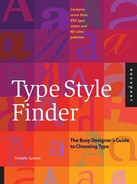
14
Interactions of Type and Color
Color exhibits a number of spatial properties in addition to its
psychological aspects and thus has a profound effect on compo-
sition and legibility when applied to type. Cool colors appear to
recede, whereas warm colors appear to advance. Of the primary
colors, blue appears to recede and yellow to advance, but red
appears to sit statically at a middle depth within space. A color
appears darker the less there is of it. A large rectangle and a
narrow line of the same color, for example, will appear to have
different values if set against a white background: the color in
the rectangle will appear lighter than it does in the line, because
the line is surrounded by much brighter white space. A designer
must pay careful attention to the relative values of colors and
their effect on legibility, especially in instances in which a col-
ored background interacts with colored type. As their values
approach each other, the contrast between type and background
diminishes, and the type becomes less legible. It is important to
maintain considerable contrast between the type color and the
background color so that the type remains visible.
The application of color to a typographic composition has an
immediate effect on hierarchy. The intrinsic value relationships
of typographic color in a hierarchy may be exaggerated, and
therefore clarified, through the application of chromatic color.
For example, if information at the top of a hierarchy is set in a
deep, vibrant orange-red, while the secondary information is
set in a cool gray, the two levels of the hierarchy will be visually
separated to a much greater degree. The application of color
to the ground within a composition can further enhance the
hierarchy. Type in one color, set on a field of another color, will
either join closely with the field or separate from it aggressively,
depending on the relationship between the two colors. If the
colors of type and background are related, the two elements
will occupy a similar spatial depth. If they are complementary,
they will be forced apart. Color may also be used to link related
informational components within a hierarchy. In an event poster,
for example, all the information related to the time and place
of the event may be assigned a particular color, related to that
assigned to the title of the event, but contrasting supporting
text. The color relationship of the title and location components
creates a meaningful link for the viewer.
A Type and Color Primer
As the relative values, temperatures, and saturation
of type and background change, so do their apparent
spatial relationships—along with legibility. Contrast
in hue and temperature help create clear separation,
as does a strong contrast in value. As the value of a
background’s color comes closer to that of the type
on top, there is a loss of separation and, therefore,
legibility—especially when complements interact.
(Provision) Type Style Finder
CD606.006 / 4108
1 TSF_FM_001-015_new.qxd 6/3/06 10:25 AM Page 14
..................Content has been hidden....................
You can't read the all page of ebook, please click here login for view all page.
